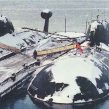
Another Disaster in the Russian Navy
Publication: Eurasia Daily Monitor Volume: 5 Issue: 216
By:

On November 8 Russia’s President Dmitry Medvedev ordered Defense Minister Anatoliy Serdyukov to instigate a full and thorough investigation into a fire on board a nuclear-powered submarine, the latest accident to afflict the Russian navy. Russian officials refused to identify the submarine, but a source in the Amur shipyard administration said the vessel was the K-152 Nerpa, a submarine of the Project 971 Shchuka-B type, or Akula-class by NATO classification, according to RIA Novosti. Sources in the Pacific Fleet command said that the accident took place in the bow section of the submarine, which represented no threat to the reactor, which is in the submarine’s stern (RIA Novosti, November 8). This comes after a series of grave naval accidents: in 2000 the nuclear submarine Kursk sank in the Barents Sea after an explosion on board, resulting in 118 deaths; in 2003 nine sailors were killed in the Barents Sea on board a K-159 submarine, while it was being towed to port for decommissioning; and in 2005 a mini-submarine became snared in a fishing net requiring the assistance of a British rescue team.
(CLICK HERE FOR AN INTERACTIVE MAP)
Among the Nerpa’s 20 dead were three naval officers and 17 civilians, all victims of suffocation as a result of Freon gas accidentally released to quell a non-existent fire. The 21 injured on board were airlifted to a Pacific Fleet hospital and treated for poisoning, and the submarine returned to the port of Bolshoi Kamen in Russia’s Far East, the site of a large refitting shipyard, where the 20 dead were taken ashore. Conflicting reports suggested that a lack of gas masks and over reliance on automated procedures could have combined with a lack of safety training for the civilians on the submarine. As the investigation began, the usual cycle of speculation and state secrecy, marked by a failure for anyone in officialdom to admit accountability, masked the underlying darker story of the Nerpa disaster. (RIA Novosti, Moscow, November 8, 9; Interfax, Moscow, November 9).
In the context of such a serious naval tragedy, the Russian Naval top brass were eager to keep the disaster from further damaging the already weakened image of Russia’s beleaguered navy. The navy command said that the 8,140-ton submarine had not yet entered service in the Russian navy. “The nuclear submarine has not come into service with the navy and was at the stage of shipyard sea trials that are conducted by a shipyard’s trial crew. The handover was scheduled for the end of the year,” explained naval spokesman Captain Igor Dygalo. The response from the authorities was predictable, with the Prosecutor-General’s Office already talking publicly about instituting “criminal proceedings,” in a bid to reassure the Russian public that culprits would be found for this latest disaster (NTV, November 9).
In late October representatives from the Amur shipyard announced that running tests of the Nerpa nuclear-powered submarine (Project 971 Shchuka-B, NATO classification Akula) had begun in Maritime Territory. The Nerpa (Seal) was originally ordered in 1991, but the collapse of the USSR resulted in constant setbacks in its construction. By the mid-1990s it seemed almost an embodiment of the problems facing the post-Soviet Russian navy. At that time it was named Bars (leopard) and was around 85 per cent complete but with no progress on its final stage of construction. After years of non-activity, in which it lay in Russia’s Far East awaiting completion, it was finally renamed the Nerpa and scheduled for sea trials in 2008 (RIA Novosti, November 8). Problems at the Amur shipyard, including pay stoppages and the arrest of a shareholder in December 2007, further delayed completion and may also have contributed to safety problems in the submarine.
Russia’s Pacific Fleet had been earmarked to receive two nuclear-powered submarines and a modern aircraft carrier, according to its commander Vice Admiral Konstantin Sidenko. It is planned to add an aircraft carrier of a new class to the fleet within the next decade, and two nuclear missile submarines of the 955 Borey project equipped with the advanced missile system Bulava are scheduled for introduction by 2012. “The government and the president of the Russian Federation have approved a program on the development of a concept of building an aircraft carrier of a new class for the Pacific Fleet. Within the next ten years, we will probably receive it,” Admiral Sidenko suggested. He knows the past record of his political masters well enough, however, to add the caveat “probably.” Currently the Russian Pacific Fleet is comprised of five strategic missile submarines, 18 multipurpose submarines, and 56 warships of various classes. The Pacific Fleet reportedly faces personnel cuts starting next year, which will include the removal of more than 4,500 officer posts (ITAR-TASS, October 27). Sidenko may look with some alarm at this latest disaster, as the Nerpa was apparently due to be leased to the Indian navy prior to securing a $2 billion deal for Russia to supply the Indian navy with two submarines. In theory, the Nerpa should have been a cutting edge example of what Russia can export to foreign navies; the reality, however, turned out far from an exemplary model, instead underscoring the continuing crisis in Russia’s navy and its overall military reform plans.
Nonetheless, in his recent address to Russia’s Federal Assembly President Medvedev said, “Regarding the re-outfitting of the army and navy with new, modern equipment, I have already made the relevant decisions.” Russia’s navy is plagued by problems that emanate from the continued dream of the Kremlin to attain a blue-water navy that can once again compete with the United States. Until this approach is finally jettisoned and planners are tasked with reforming and equipping the type of navy Russia actually needs, rather than one it cannot afford and is not able to build and maintain, then more such disasters can be anticipated. With the Nerpa due for lease to India’s navy, the latest disaster may also damage Russia’s international reputation as an arms exporter.





